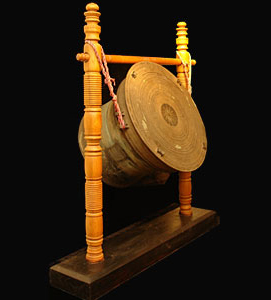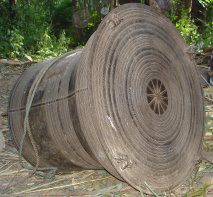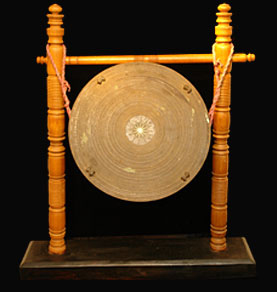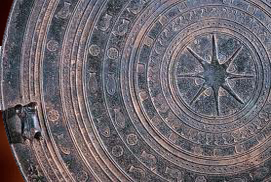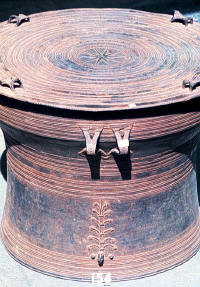Karen Bronze Drum |
|
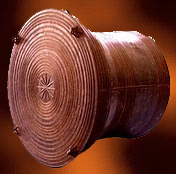
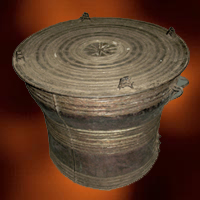
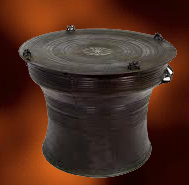
|
Bronze Drums - An Animist Art Form by Dr. Richard M. Cooler , Professor Emeritus Art History of Southeast Asia, Northern Illinois University Original link @ http://www.seasite.niu.edu/burmese/cooler/Chapter_1/Chapter_1.htm
The vibrating tympanum is made of bronze and is cast as a continuous piece with the cylinder. Distinguishing features of the Karen type include a less bulbous cylinder so that the cylinder profile is continuous rather than being divided into three distinct parts. Type III has a markedly protruding lip, unlike the earlier Dong Son drums. The decoration of the tympanum continues the tradition of the Dong Son drums in having a star shaped motif at its center with concentric circles of small, two-dimensional motifs extending to the outer perimeter.
A Karen innovation was the addition of three-dimensional figures to one side of the cylinder so that insects and animals, but never humans, are often represented descending the trunk of a stylized tree.
The frogs on the tympanum vary from one to three and, when appearing in multiples, are stacked atop each other. The number of frogs in each stack on the tympanum usually corresponds to the number of figures on the cylinder such as elephants or snails. The numerous changes of motif in the two- and three-dimensional ornamentation of the drums have been used to establish a relative chronology for the development of the Karen drum type over approximately one thousand years. These hillside people practice swidden or slash-and-burn agriculture and speak a language that is very different than that of the lowland Burmese. The practice of slash-and-burn agriculture consists of burning the forests and then using the ashes from the burnt timber as fertilizer for the fields.
The fertilizer lasts for only several years, never more than six, and at that time the Karen must pack and move everything to a new site where a different section of the forest is burned. A number of hillside groups practice slash-and-burn agriculture and periodically move through each other's hereditary territory to new lands. These people move back and forth across the Thai border with little regard for the national boundary. Slash-and-burn agriculture is perilous in that after the forest is burned, seeds must be planted and then rains must occur quickly and consistently until the plants are well established. If this does not happen, the plants will wither and die or insects and animals will eat the seeds. It is not unusual for the Karen to be forced to plant four times in order to reap a single harvest. For the Karen, the bronze drums perform a vital service in inducing the spirits to bring the rains. When there is a drought, the Karens take the drums into the fields where they are played to make the frogs croak because the Karens believe that if the frogs croak, it is sign that rain will surely fall. Therefore, the drums are also known as "Karen Rain Drums" Bronze drums were used among the Karen as a device to assure prosperity by inducing the spirits to bring rain, by taking the spirit of the dead into the after-fife and by assembling groups including the ancestor spirits for funerals, marriages and house-entering ceremonies. The drums were used to entice the spirits of the ancestors to attend important occasions and during some rituals the drums were the loci or seat of the spirit. It appears that the oldest use of the drums by the Karen was to accompany the protracted funeral rituals performed for important individuals. The drums were played during the various funeral events and then, among some groups, small bits of the drum were cut away and placed in the hand of the deceased to accompany the spirit into the afterlife. It appears that the drums were never used as containers for secondary burial because there is no instance where Type III drums have been unearthed or found with human remains inside. The drums are considered so potent and powerful that they would disrupt the daily activities of a household so when not in use, they were placed in the forest or in caves, away from human habitation. They were also kept in rice barns where when turned upside down they became containers for seed rice; a practice that was thought to improve the fertility of the rice. Also, since the drums are made of bronze, they helped to deter predations by scavengers such as rats or mice. When played, the drums were strung up by a cord to a tree limb or a house beam so that the tympanum hung at approximately a forty-five degree angle. The musician placed his big toe in the lower set of lugs to stabilize the drum while striking the tympanum with a padded mallet. Three different tones may be produced if the tympanum is struck at the center, edge, and midpoint. The cylinder was also struck but with long strips of stiff bamboo that produces a sound like a snare drum. The drums were not tuned to a single scale but had individualized sounds, hence they could be used effectively as a signal to summon a specific group to assemble. It is said that a good drum when struck could be heard for up to ten miles in the mountains. The drums were played continuously for long periods of time since the Karen believe that the tonal quality of a drum cannot be properly judged until it is played for several hours. The drums were a form of currency that could be traded for slaves, goods or services and were often used in marriage exchanges. They were also a symbol of status, and no Karen could be considered wealthy without one. By the late nineteenth century, some important families owned as many as thirty. The failure to return a borrowed drum often led to internecine disputes among the Karen. a. Animist Drums and Buddhism Although the drums were cast primarily for use by groups of non-Buddhist hill people, they were used by the Buddhist kings of Burma and Thailand as musical instruments to be played at court and as appropriate gifts to Buddhist temples and monasteries. The first known record of the Karen drum in Burma is found in an inscription of the Mon king Manuha at Thaton, dated 1056 AD. The word for drum in this inscription occurs in a list of musical instruments played at court and is the compound pham klo: pham is Mon while klo is Karen. The ritual use of Karen drums in lowland royal courts and monasteries continued during the centuries that followed and is an important instance of inversion of the direction in which cultural influences usually flow from the lowlands to the hills. The town of Nwe Daung, 15 km south of Loikaw, capital of Kayah (formerly Karenni) State, is the only recorded casting site in Burma. Shan craftsmen made drums there for the Karens from approximately 1820 until the town burned in 1889. Karen drums were cast by the lost wax technique; a characteritic that sets them apart from the other bronze drum types that were made with moulds. A five metal formula was used to create the alloy consisting of copper, tin, zinc, silver and gold. Most of the material in the drums is tin and copper with only traces of silver and gold. The Karen made several attempts in the first quarter of the twentieth century to revive the casting of drums but none were successful. During the late 19th century, non-Karen hill people, attracted to the area by the prospect of work with British teak loggers, bought large numbers of Karen drums and transported them to Thailand and Laos. Consequently, their owners frequently incorrectly identify their drums as being indigenous to these countries.
Click to learn more about Karen drums
|
